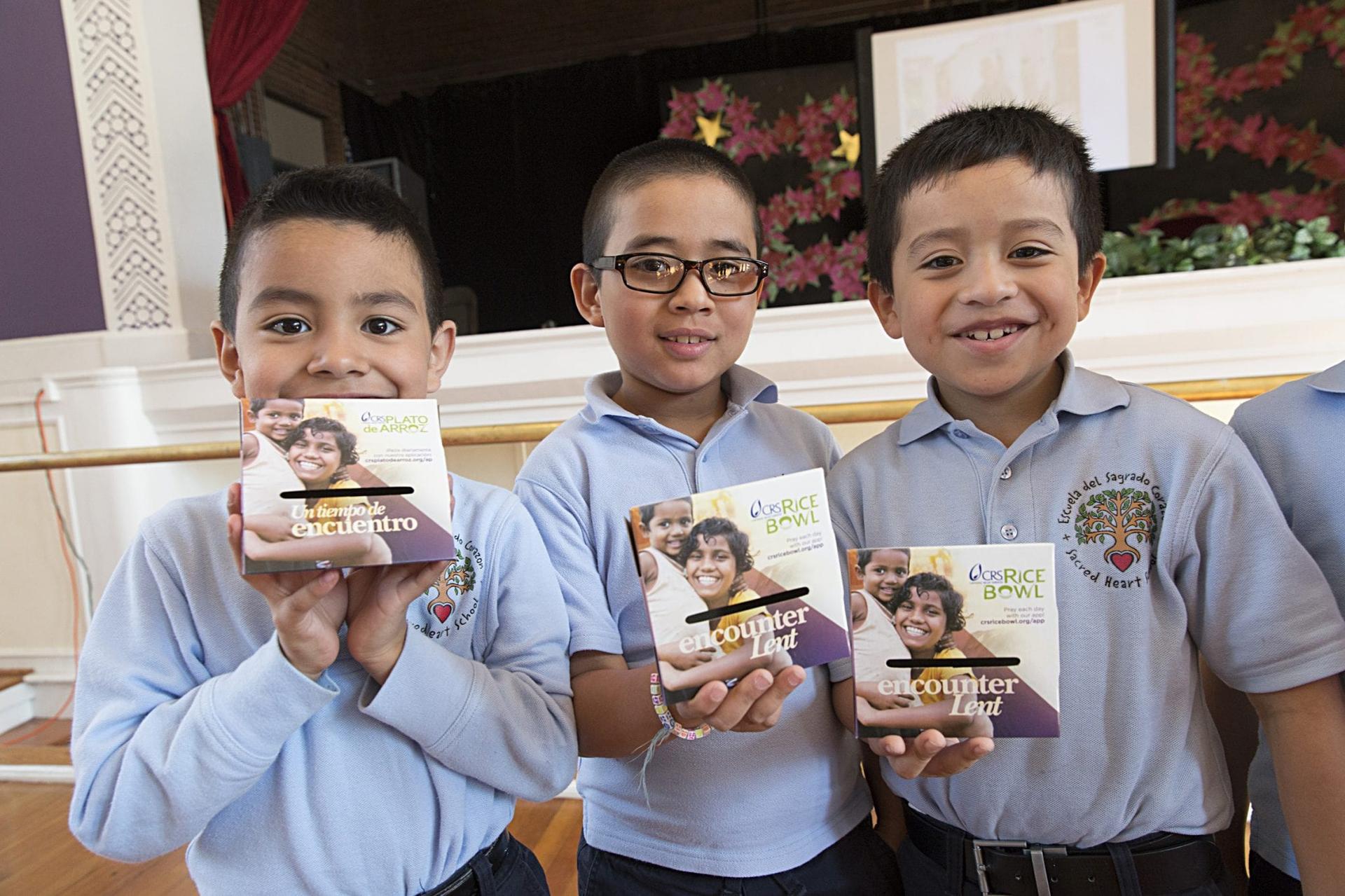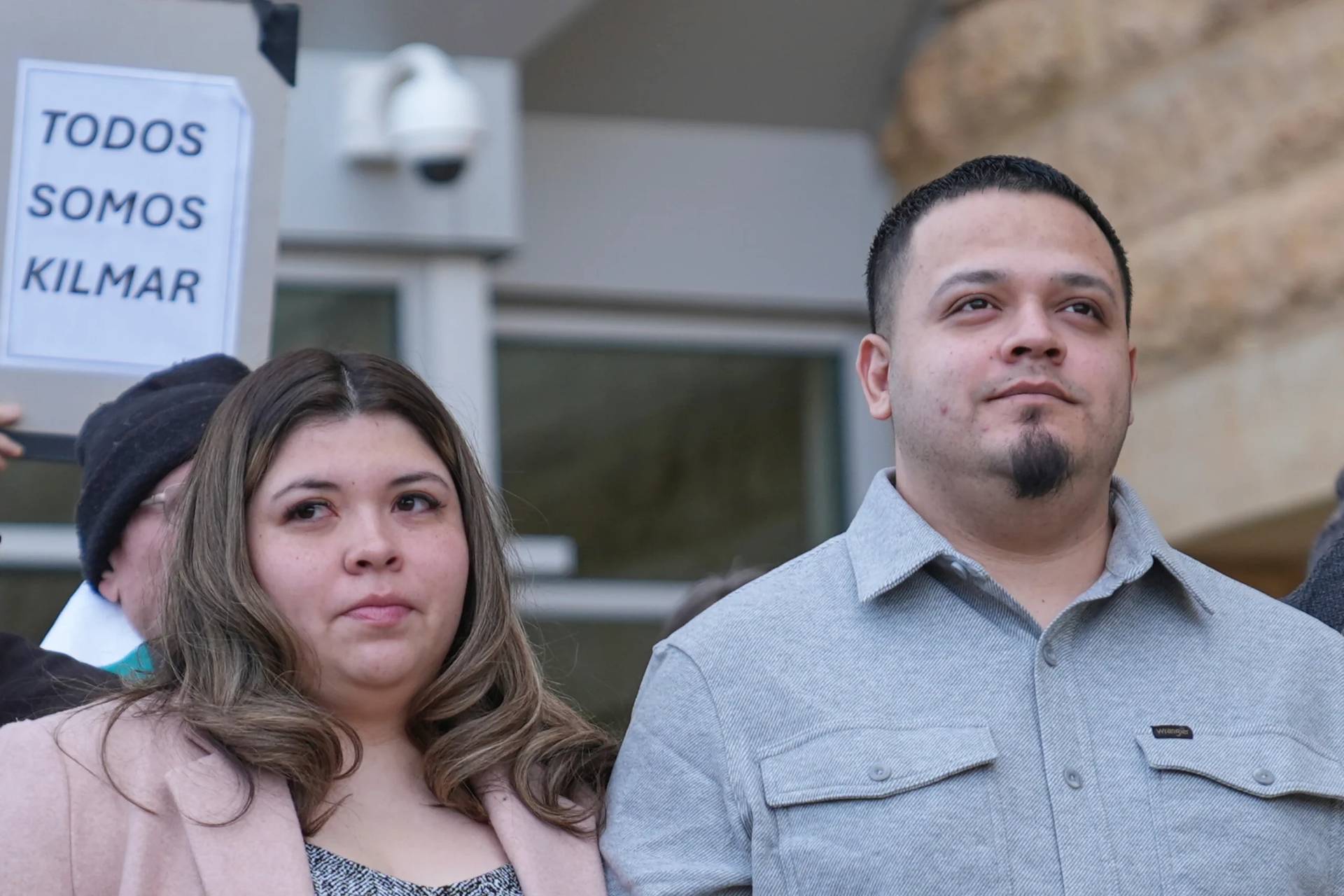When Cecilia Suarez, the head of office for Catholic Relief Services (CRS) in Mexico, saw the photo of herself that began her slideshow, she laughed, explaining people seeing that picture expect her to be taller in real life. But she pointed out that she was standing next to two very petite women in Mexico.
And the point of her talk was about how something small – like the cardboard Rice Bowl box that Catholic schoolchildren, families, university students and parishioners across the United States have been filling with coins and dollars as a Lenten sacrifice over the past four decades – can have a big impact on the lives of the poor.
“I can testify, something that appears to be small… It’s a huge help. It’s not a drop that gets lost in the water,” she said, noting that if people donate even just a dollar into the box for each of the 40 days of Lent, it can help make a difference.
The Rice Bowl box supports key outreach for CRS, the official international humanitarian agency of the Catholic Church in the United States.
The Rice Bowl box notes that $1 a day for the 40 days of Lent would support three months of clean water for four families, or two years of seed for a farmer, or one month of food for a family in a poor country. CRS has outreach programs in more than 100 countries around the world, and those programs touch more than 100 million lives, according to the agency.
Last year, nearly 14,000 faith communities from every diocese in the United States participated in the Rice Bowl program, contributing $11.2 million. Three-fourths of those contributions go to CRS outreach efforts in other countries, and one-fourth stays in the local dioceses to support programs aimed at alleviating poverty and hunger.
Speaking on March 2 at the Archdiocese of Washington’s Pastoral Center in Hyattsville, Maryland, Suarez said the Rice Bowl program supported CRS’s community development, migration outreach and peacebuilding efforts in Mexico.
“The power of these small boxes is huge,” she said, adding that it also helps U.S. children gain a perspective on the challenges faced by other people around the world.
“To me, it has been like building bridges of solidarity between our two countries,” she said.
In the Washington area, Suarez addressed students at Sacred Heart School, a Catholic elementary school with a bilingual English and Spanish educational program; and she spoke to young adults after an Ash Wednesday Mass at St. Thomas Apostle Church in the nation’s capital; to parishioners at St. Martin of Tours Parish in Gaithersburg, Maryland; to students at Bishop McNamara High School in Forestville, Maryland, and to children at St. Michael’s School in rural Ridge, Maryland.
To kick off the promotion of the Rice Bowl program each Lent, CRS representatives from different countries visit regions of the United States. Suarez gave presentations in Philadelphia; Hartford, Connecticut; and concluded by giving talks in the Washington, D.C. area, where Mexico and the immigration issue have been a source of controversy, as the Trump administration has pledged to build a wall along the southern U.S. border and increase enforcement of laws restricting unauthorized immigration.
Suarez noted that her country and its people “have been in the news lately, a lot,” and she told the Washington audience, “I hope my presentation will provide a different angle about what people are facing in my country.”
Nearly 50 percent of Mexicans live in poverty, she said, highlighting the story of four sisters in a desert region of Mexico who are now grandmothers, helping to support the younger members of their families in a rural area where the poor soil and lack of rain have led adults to seek work elsewhere as migrant farm workers, whose 16-hour work days net only about $6.
CRS has helped those women – including a grandmother named Maria who is highlighted in the Rice Bowl’s weekly Lenten promotions – form a cooperative to grow ornamental cactuses in greenhouses. The plants are being sold with the help of the Walmart Foundation, and university students are helping the grandmothers market the plants for online sales.
“This small program is empowering them. They are seeing a better future for their grandchildren,” Suarez said.
Those women are “amazing,” said the CRS official, who described how she is inspired by their faith and their spirit, and their promises to pray for her, her family and her work.
“They live happy, always with hope. They always believe the next day is better,” said Suarez, adding, “We care about things that are not really important. These people are happy, full of joy.”
Suarez said the peacebuilding programs operated by CRS in Mexico try to help families foster peace in their communities in a country plagued by murders, kidnappings, violence and disappearances.
“We hope these families will be leaders of a new Mexico,” she said.
In her country, CRS also assists the Catholic Church in serving the hundreds of thousands of Central Americans fleeing into Mexico each year. Many are victims of gang violence in their home countries and then organized crime on their migrant journeys, and church programs help provide them with food, water and shelter.
Now as it becomes more difficult for those immigrants to enter the United States, “we are calling them stuck migrants,” Suarez said. “They are trapped in this position” in Mexico.
Asked about the biggest misconceptions that U.S. leaders and citizens have about the immigration issue, Suarez said she believes it is a mistake to frame the issue “as a security problem instead of a development problem.”
The CRS official contends that building a wall on the U.S. border with Mexico won’t solve the problem.
“We need to change opportunities in our country, so people don’t feel forced to migrate,” she said. The migrants’ journey, she said, is not a matter of seeking “the American dream.”
In her view, it’s motivated by them fleeing “the Mexican and Central American nightmare” of violence and poverty. “I would call this a humanitarian emergency,” she said. “…I think we need to change the approach.”
Like all of Catholic Relief Services’ outreach efforts, the Lenten Rice Bowl program was formed, and continues, as a way to bring help and hope to the poor across the world. The effort began in 1975 as a response to the famine in Africa. In its first 40 years, U.S. Catholics have donated more than $250 million to the CRS Rice Bowl.
In an email interview with Crux, Eric Clayton, the CRS Rice Bowl program manager, said the effort builds on the three pillars of Lent – prayer, fasting and almsgiving – “in such a way that it gives people at any age a way to bring Lent closer to their daily lives.”
In addition to the small cardboard box – which for generations of U.S. Catholics, has become almost as recognizable a symbol of Lent as ashes on people’s forheads – donations can be made to the Rice Bowl program through the website www.crsricebowl.org and now also through an app available on both Android and Apple devices.
The CRS Rice Bowl program offers a Lenten calendar with daily prayers for individuals and families, and for each week of Lent, the program highlights the personal story of a different recipient of CRS programs around the world, with the recipe for a simple meatless meal from that person’s country that people can make, including pupusas from El Salvador, red rice from Mexico, and a cabbage and crepe dish from Ethiopia.
This year’s Rice Bowl theme, “Encounter Lent,” builds on Pope Francis’s encouragement for the world’s Catholics to encounter people on the margins of society and bring them Christ’s love and hope.
“This year, CRS Rice Bowl is designed to help participants encounter ourselves, our neighbor and our God anew,” Clayton said.
For Catholic schoolchildren, the Rice Bowl gives them their first encounter with supporting the work of Catholic Relief Services, which many continue through adulthood.
For the poor around the world, those coins and dollars support development programs that help them find a brighter future.
And for local programs that benefit from Rice Bowl donations, that effort brings help and hope to the poor in U.S. communities and neighborhoods, like the food pantry at St. Martin of Tours Parish in Gaithersburg, Maryland, which provides groceries to nearly 200 people each week. The day of Suarez’s talk, a grant from the local Rice Bowl donations was going toward paying for necessary repairs to the walls of the pantry, to keep it up to health codes.
Suarez, who knows that good things can come in small packages, told her audience in Washington, “You do a lot here that is helping change the lives of people.”















